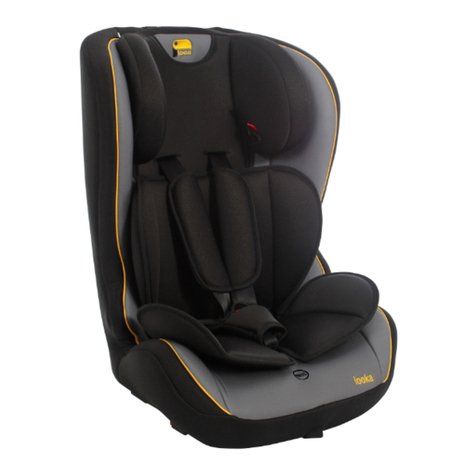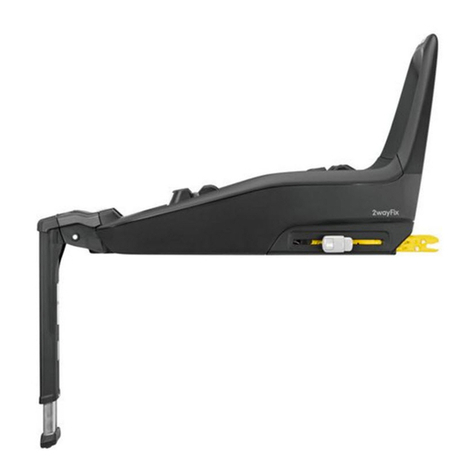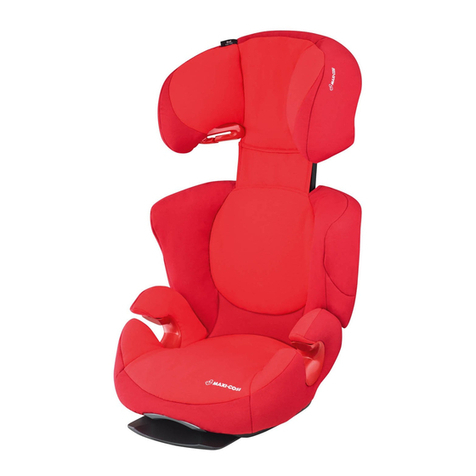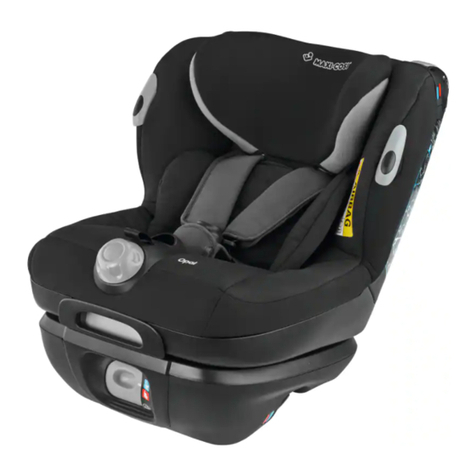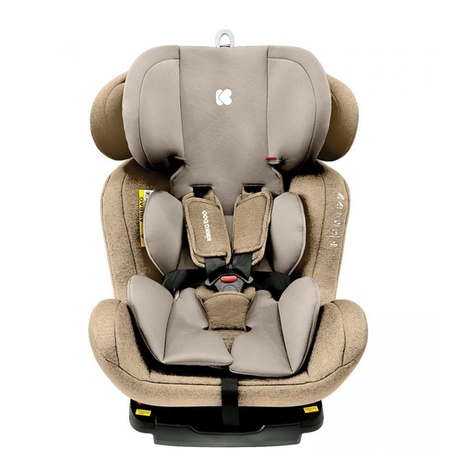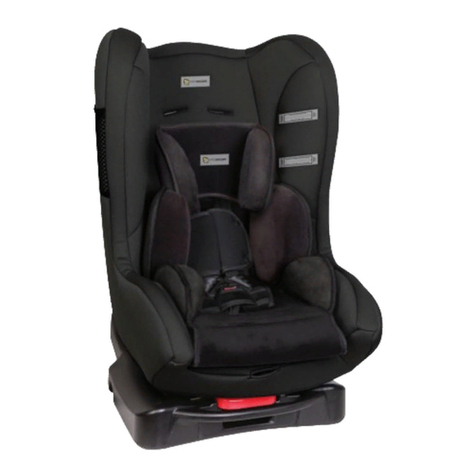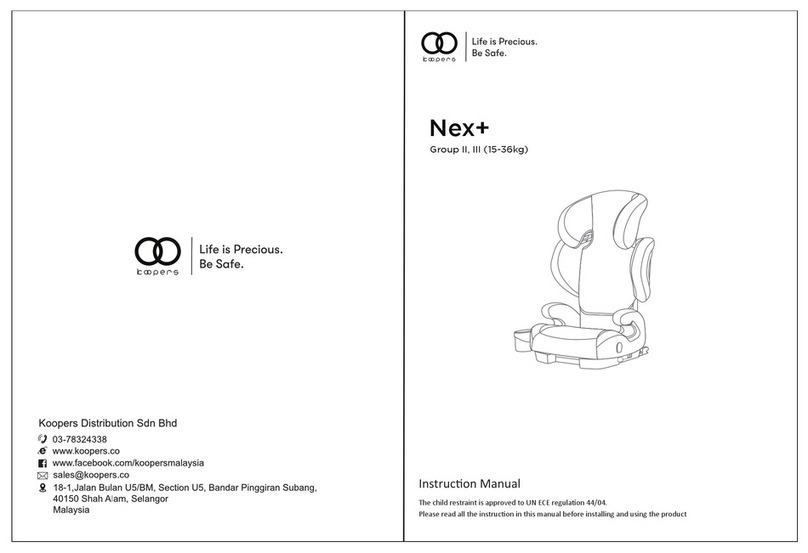Toco grow-fix User manual

This product conforms to ECE R44.04
Group 1,2,3 child car seat.
Suitable for children from 9kg to 36kg (approx 9 months to 12 years old)
ISOFIT CAR SEAT
INSTRUCTIONS: PLEASE READ CAREFULLY AND
KEEP FOR FUTURE REFERENCE. YOUR CHILD’S
SAFETY MAY BE AFFECTED IF YOU DO NOT
FOLLOW THESE INSTRUCTIONS.
grow-fix
Group 1,2,3
V1

2
Contents
Welcome
Your 3 year warranty
Thank you for purchasing the Toco Grow-fix Group 1,2,3 Car Seat.
Please read these instructions carefully before use to ensure safe and satisfactory operation of
this product.
Your child’s safety is your responsibility.
This seat can either be fitted using the ISOFIT system (also known as ISOFIX) in conjunction
with the vehicle’s 3-point safety belt or by just using just a standard 3-point vehicle seat belt. It
is advised that if your vehicle has ISOFIT anchor points then the seat should be fitted using the
ISOFIT system.
Whilst we make and test our products to the highest standards of durability there’s always a
small chance of a hiccup! Our promise is to repair, replace or refund a Toco product that has
an identified manufacturing defect from the date of purchase for a full 3 years thereafter at no
extra cost.
However, you must register within 28 days of the date of purchase to receive the full 3 years
guarantee!
To receive your full guarantee you can register your product by:
visiting www.tocobaby.co.uk/warranty.html and complete the warranty form,
or by telephone on 0161 335 2508.
Welcome 2
Your 3 year warranty 2
Safety information 3-5
Parts Checklist 6
Adjusting the headrest 7
Converting the seat to a group 3 backless booster 7
Positioning the car seat 8
Removing the seat cover 19-20
Fitting the seat cover 20-22
Care and maintenance 23
Placing your child in the car seat [group 1] 15-16
Placing your child in the car seat [group 2,3] 16-17
Placing your child in the group 3 booster seat 18
Installing the seat using only the vehicle’s 3-point seatbelt [groups 1,2,3] 13
Installing the group 3 booster seat using only the vehicle’s 3-point seatbelt 14
Attaching the ISOFIT guides 8
Installing the group 1,2,3 car seat using the vehicle’s ISOFIT system 9-10
Installing the group 3 booster seat using the vehicle’s ISOFIT system 10-11
Removing the group 1,2,3 car seat when using the vehicles ISOFIT system 12

3
Contents
Safety
1. This child car seat is approved for two different types of fitting:
a) “Semi-Universal” with connectors locked onto the vehicle’s ISOFIT anchor points [also
known as ISOFIX anchor points], used in conjunction with the vehicle’s 3-point safety belt.
b) “Universal” for use with just the vehicle’s 3-point safety belt.
2. This is a “Universasl” child restraint. It is approved to ECE R44.04 For general use in
vehicles and will fit most, but not all, car seats.
3. A correct fit is likely if the vehicle manufacturer has declared in the vehicle handbook that
the vehicle is capable of accepting a Universal child restraint for the stated age group.
4. This child restraint has been classified as UNIVERSAL under more stringent conditions
than those which applied to earlier designs which do not carry this notice.
5. If in doubt, consult either the manufacturer or the retailer.
6. Only suitable if the approved vehicles are fitted with 3-point/static/retracting seat belts
which are approved to ECE R16 or equivalent.
7. This is a “Semi-Universal” ISOFIT CHILD RESTRAINT SYSTEM. It is approved to ECE
R44.04 For general use in vehicles fitted with ISOFIT anchorage systems.
8. It will fit vehicles with position approved ISOFIT attachment points (consult the vehicle
handbook), depending upon the category of the child seat and of the ISOFIT fixture position.
NOTICES
Read carefully before attempting to fit the child car seat
WARNING: NEVER leave your child unattended – your child’s safety is your responsibility.
WARNING: The child car seat must be fitted in accordance with the manufacturer’s instructions.
Incorrect installation could be dangerous.
WARNING: This installation must only be performed by a competent adult. Don’t try to install the
seat when intoxicated or drowsy.
WARNING: Always ensure that new or occasional users [e.g. Grandparents] have read the
instructions or been taught the correct installation by someone who has read and understood
the instructions.
WARNING: Always keep this instruction manual with the child car seat, or in the vehicle in which
you are carrying the child car seat. Some models of child car seat have a pocket to store the
instructions.
Getting started
Before starting
WARNING: Do not fit the child car seat on a side or rear facing vehicle seat.
WARNING: Before installing the child car seat ensure that the passenger seat you are using is
locked in the upright position.
WARNING: Do not use the child car seat in the home - it has only been designed to be used in
the car.
WARNING: Do not leave loose/unsecured objects on the back seat of your car or the parcel
shelf. They may be dangerous to your child if you are forced to brake suddenly.

4
WARNING: Make sure that the child car seat is placed somewhere so that rigid items and plastic
parts do not become trapped in doors or movable seat units when the seat is in everyday use.
WARNING: Always use the vehicle’s door child safety lock system, if one is available, to make it
impossible for the child to open the car doors from inside.
WARNING: Allow the child a break during long car journeys and make sure they don’t get out of
the car unaided and without supervision.
WARNING: The child car seat must be fitted securely to the passenger seat. Ensure that it is not
loose or wobbly after you have fitted it. If it is loose, re-fit it.
WARNING: The child car seat must not be used without its original cover. The original cover is
essential for the safe operation of the child car seat.
WARNING: Stop the car at regular intervals to check that the child car seat is in the correct
position and that both the car seatbelt (if used) AND the child car seat harness are still taut and
latched.
WARNING: Ensure that no part of the child car seat is trapped in a door or folding seat.
WARNING: In the event of an emergency it is important to be able to release the child quickly (as
defined by british standards). This means that the seat buckle cannot be fully tamper proof and
you should actively discourage your child from playing with or using the buckle.
WARNING: If you travel with passengers using both the front and the rear passenger seats, the
lighter occupants should be in the rear and the heavier occupants in the front.
WARNING: If you have no option other than to put your child car seat on a rear passenger seat
next to side airbags:
- Consult with your vehicle manufacturer for side airbag details. It may not be safe.
- Make sure your child does not lean into the area immediately around the airbag.
WARNING: Do not place anything under the child car seat (e.G. A towel or cushion) as this could
affect the performance of the seat in an accident.
WARNING: Avoid winter clothing bundling - bulky clothing can lead to incorrect harness
tightening. In an accident, the child can slip right out of the extra padding - and thus out of the
seat. Let the car warm up or cool down prior to placing your child in there if possible. If your
child is cold, place a blanket over the top of the harness.
If your centre rear passenger seat is fitted with a three point seatbelt system then you should
use it.
If your centre rear passenger seat does not have a three point seatbelt system (i.E. No seatbelt
at all, or only a lap belt)
- Then you should use the rear left passenger seat or the rear right passenger seat.
The front passenger seat can only be used if it DOES NOT have an airbag and IS fitted with a
three point seatbelt system.
EXTREME HAZARD
NEVER USE IN FRONT PASSENGER SEATS EQUIPPED WITH
AIRBAGS (SRS). THIS CAN INCLUDE REAR PASSENGER SEATS
THAT ARE EQUIPPED WITH AIRBAGS*
*Consult car manufacturer for suitability. Children’s bodies are not able to
withstand the forces exerted on them by a deploying air-bag
Which is the safest passenger seat for the child seat?
When using the child car seat

5
Which is the safest passenger seat for the child seat?
Seatbelt
Sunlight/hot days
WARNING: Never use any load bearing contact points other than those described in these
instructions or marked on the child car seat.
WARNING: Ensure that the lap section of the harness is worn low down, so that the pelvis is
firmly engaged.
WARNING: Make sure that ALL the passengers in your vehicle have their seatbelts fastened, as
unrestrained people can be very dangerous to the child in an accident.
WARNING: NEVER use a seatbelt routing scheme that differs from these instructions.
WARNING: The harness must be used at all times when your child is in the child car seat.
WARNING: If you are installing the child car seat using a seatbelt ensure there are no twists in
the seatbelt.
WARNING: Don’t leave your child in the child car seat while parked in direct sunlight or on a hot
day.
WARNING: Do not subject the child car seat to prolonged direct sunlight as this may be
dangerous for your child (the metal and plastic fittings could become hot) and may cause the
fabric to fade. You can reduce this problem by covering the child car seat with a sheet when not
in use.
WARNING: Ensure that the child car seat is as close as possible to the backrest of the car seat.
WARNING: REMOVE the headrest of the passenger seat being used if it obstructs the proper
installation of the child car seat. REMEMBER to refit the headrest when the child car seat has
been removed.
Back of the seat/headrest
WARNING: NEVER buy a second hand child car seat. It may have unseen damage.
WARNING: The manufacturer only guarantees this product when the original owner uses it.
WARNING: You MUST replace the child car seat and your vehicles seatbelts if they becomes
badly worn or damaged.
WARNING: You MUST replace the child car seat if it is involved in an accident – it may have
unseen damage and may not protect your child as well as they should. At the very least send the
child car seat to the manufacturers for inspection, together with the accident report.
Second hand or damaged child car seats and seatbelts

6
Parts checklist
1Headrest 7Red ISOFIT adjust lever
2Impact shield 8Headrest adjust lever
3Seatbelt guide 9Shoulder belt guides
4ISOFIT arms 10 Instruction manual pocket
5Lap belt guide 11 ISOFIT guides
6ISOFIT release button
1
3
4
5
6
7
11
8
9
10
2

7
Parts checklist
Adjusting the headrest
1. Squeeze the handle at the back of the seat and
raise or lower the headrest as needed.
Ensure the shoulder belt guide (A) is at the correct
height for your child’s shoulders and not too high
or too low.
A
1. Holding the car seat base with one hand, push the backrest away from you until it is at on the
oor. e backrest can now be removed from the base.
Store the backrest safely in case it is required again in future.
To reattach the backrest: slot the bottom of the backrest into the seat base and then pull the
backrest back up into an upright position until it clicks into position.
Snap
Converting the seat to a group 3 backless booster

8
1. If your vehicle has ISOFIT points then we advise that they are used.
To check if you have ISOFIT points, feel between the joint of the passenger seat back and
passenger seat base (A) for two metal brackets similar to (B). If unsure or in any doubt then consult
your vehicle manufacturer.
Press the plastic ISOFIT guides (C) over the two ISOFIT anchor points (B).
AB
C
The child car seat should only be
installed using either the ISOFIT anchor
points or the vehicle’s 3-point seatbelt on
a forward facing passenger seat.
WARNING: Never attempt to use a
2-point seatbelt to secure the seat.
WARNING: Never use on a seat with
an active airbag.
WARNING: Never use on rearward or
side facing vehicle seats.
USING ISOFIT SYSTEM
Front passenger seat (no active airbag) Yes
Front passenger seat (active airbag) NO
Back left & right seats Yes
Back centre seat (with ISOFIT points) Yes
Side facing seats NO
Rear facing seats NO
USING VEHICLE’S 3-POINT SEATBELT
Front passenger seat (no active airbag) Yes
Front passenger seat (active airbag) NO
Back left & right seats Yes
Back centre seat (2-point seatbelt) NO
Back centre seat (3-point seatbelt) Yes
Side facing seats NO
Rear facing seats NO
Positioning the car seat
Attaching the ISOFIT guides

9
Installing the group 1,2,3 car seat using the vehicle’s
2. Pull the red lever (A) at the front of the
car seat to extend the two ISOFIT arms
(B).
1. Place the car seat on a suitable passenger
seat.
Note: If the passenger seat has a headrest
then it must be removed before tting the
car seat.
B
A
ISOFIT system
3. Hold the seat with both hands and slide
the seat back, guiding the two ISOFIT
arms into the insert guides till the two
arms lock securely with a “click” onto both
ISOFIT anchor points.
Click 4. IMPORTANT! Check that BOTH
lock indicators on each side of the seat
have turned green indicating the seat is
LOCKED in position.
Pull the seat forward to check that the
ISOFIT system is locked in place
green red

10
5. Pull the red lever at the front of the seat and push the base of the car seat back towards the
passenger seat as far as it will go (C).
Hold the seat base and push the backrest (D) until it rests against the passenger seat (E).
C
D
E
E
Installing the group 1,2,3 car seat using the vehicle’s
ISOFIT system (continued)
vehicle’s ISOFIT system
Installing the group 3 booster seat using the
2. Pull the red lever (A) at the front of the
car seat to extend the two ISOFIT arms
(B).
1. Place the car seat on a suitable passenger
seat.
B
A

11
Installing the group 3 booster seat using the
vehicle’s ISOFIT system (continued)
3. Hold the seat with both hands and slide
it back, guiding the two ISOFIT arms into
the insert guides till the two arms lock
securely with a “click” onto both ISOFIT
anchor points.
Click 4. IMPORTANT! Check that BOTH
lock indicators on each side of the seat
have turned green indicating the seat is
LOCKED in position.
Pull the seat forward to check that the
ISOFIT system is locked in place
green red
5. Pull the red lever at the front of the seat and push the seat back towards the passenger seat as far
as it will go (C) until it rests against the passenger seat (D).
C
D
D

12
1. Pull BOTH lock indicator buttons
forward to release the ISOFIT system from
the anchor points.
2. Check that BOTH lock indicators have
turned from green to RED indicating the
seat is UNLOCKED.
Click
3. Pull the red lever (A) at the front of the car seat and at the same time pull one of the indicator
buttons (B) as indicated to retract the ISOFIT arms. Once the arms are full retracted, release the
red lever (A). You can now remove the car seat from the vehicle.
A
B
Removing the group 1,2,3 car seat when using the
vehicle’s ISOFIT system

13
Installing the seat using only the vehicle’s 3-point
2. Place the car seat on a suitable passenger
seat.
Note: If the passenger seat has a headrest
then it must be removed before tting the
car seat.
1. To ensure a correct t whilst only using
the vehicle’s 3-point seatbelt it is important
that the ISOFIT arms are NOT extended
and that they have been retracted into the
car seat. is will allow the car seat to rest as
ush as possible against the vehicle’s seat.
See “Removing the group 1,2,3 car seat
when using the vehicle’s ISOFIT system”
page 12 for guidance on retracting the
ISOFIT arms
IMPORTANT: If your vehicle has an
ISOFIT system with ISOFIT anchor
points then we strongly urge you to use it.
3. Push the base of the car seat back towards the passenger seat as far as it will go (A).
Hold the seat base and push the backrest (B) until it rests against the passenger seat (C).
IMPORTANT! If the seat does not seem to rest ush against the vehicle’s seat ensure you have
retracted the two ISOFIT arms.
A
B
C
C
seatbelt [groups 1,2,3]

14
1. To ensure a correct t whilst only using
the vehicle’s 3-point seatbelt it is important
that the ISOFIT arms are NOT extended
and that they have been retracted into the
car seat. is will allow the car seat to rest as
ush as possible against the vehicle’s seat.
See “Removing the group 1,2,3 car seat
when using the vehicle’s ISOFIT system”
page 12 for guidance on retracting the
ISOFIT arms
IMPORTANT: If your vehicle has an
ISOFIT system with ISOFIT anchor
points then we strongly urge you to use it. 2. Place the car seat on a suitable passenger
seat.
Installing the group 3 booster seat using only the
vehicle’s 3-point seatbelt
3. Push the base of the car seat back towards the passenger seat as far as it will go (A), until it rests
against the passenger seat (B).
IMPORTANT! If the seat does not seem to rest ush against the vehicle’s seat ensure you have
retracted the two ISOFIT arms.
A
B
B

15
Placing your child in the car seat [group1]
Ensure you have installed the car seat correctly following either the instructions under “Installing the
group 1,2,3 car seat using the vehicle’s ISOFIT system” pages 9-10 or following the instructions under
“Installing the seat using only the vehicle’s seatbelt [groups 1,2,3]” page 13.
A
1. Remove the impact shield (A). 2. Place your child into the car seat.
3. Insert the impact shield (B) under the car seat’s armrests and over your child’s legs.
Pull out as much of the vehicle’s seat belt as you can and avoiding any twists, slot the lap belt and
the diagonal belt section through the two red seat belt guides (C) on the impact shield.
B
C

16
Placing your child in the car seat [group1] (continued)
E
4. Lock the vehicle’s seat belt into the
buckle (D) ensuring it “clicks” into place.
5. Pull the lap section of the seat belt
towards the buckle (E) and then pull the
diagonal section back up towards the seat
belt anchor point (F), ensuring the seat belt
is tight along its length.
Click
D
F
1. e impact shield (A) is not required
for group 2,3 and should be removed and
stored safely. 2. Place your child into the car seat.
A
Placing your child in the car seat [group 2,3]
Ensure you have installed the car seat correctly following either the instructions under “Installing the
group 1,2,3 car seat using the vehicle’s ISOFIT system” pages 9-10 or following the instructions under
“Installing the seat using only the vehicle’s seatbelt [groups 1,2,3]” page 13.

17
Placing your child in the car seat [group 2,3] (continued)
3. Place the diagonal belt section through the shoulder belt guide (B). e diagonal belt should pass
over your child’s shoulder and should not be against their neck. If necessary adjust the headrest up
or down so that the diagonal belt passes over your child’s shoulder correctly.
Place the lap belt over your child’s lap and fasten the seatbelt ensuring the lap belt is routed under
both armrests and the diagonal belt passes under the armrest nearest the buckle (D).
D
B
C
Click
4. Check there are no twists in the seatbelt and that the diagonal section is:
(E) Resting correctly over your child’s shoulder.
(F) If the diagonal section is too high then lower the headrest.
(G) If the diagonal section is too low then raise the headrest.
E F G

18
1. e impact shield (A) is not required for
group 3 and should be removed and stored
safely along with the backrest. 2. Place your child into the car seat.
A
Ensure you have installed the car seat correctly following either the instructions under “Installing the
group 3 booster seat using the vehicle’s ISOFIT system” pages 10-11 or following the instructions
under “Installing the group 3 booster seat using only the vehicle’s 3-point seatbelt” pages 14.
Placing your child in the group 3 booster seat
3. Place the diagonal belt over your child’s shoulder and not be against their neck.
Place the lap belt over your child’s lap and fasten the seatbelt ensuring the lap belt is routed under
both armrests (B) and the diagonal belt passes under the armrest nearest the buckle (C).
Check there are no twists in the seatbelt and that the diagonal section is resting correctly over your
child’s shoulder.
C
Click
B

19
Removing the seat cover
1. Holding the car seat base with one hand, push the backrest away from you until it is at on the
oor. e backrest can now be removed from the base.
To reattach the backrest: slot the bottom of the backrest into the seat base and then pull the
backrest back up into an upright position until it clicks into position.
Snap
3. Starting at the bottom, of the backrest,
CAREFULLY pull the seat cover away
from the seat.
2. Starting from the top, remove the
elasticated cover from the impact shield.
A

20
Removing the seat cover (continued)
5. Unbutton the two press studs (C) and
holding the fabric near to the press studs,
CAREFULLY pull the base cover forward
and o from the base.
4. Unbutton the four press studs (B) and
remove the back fabric.
BB
C
2. Secure the press studs (A) on the back
fabric to the back rest.
1. Stretch the cover over the impact shield
ensuring the fabric is correctly seated
around the belt guides.
AA
Fitting the seat cover
Table of contents
Other Toco Car Seat manuals
Popular Car Seat manuals by other brands
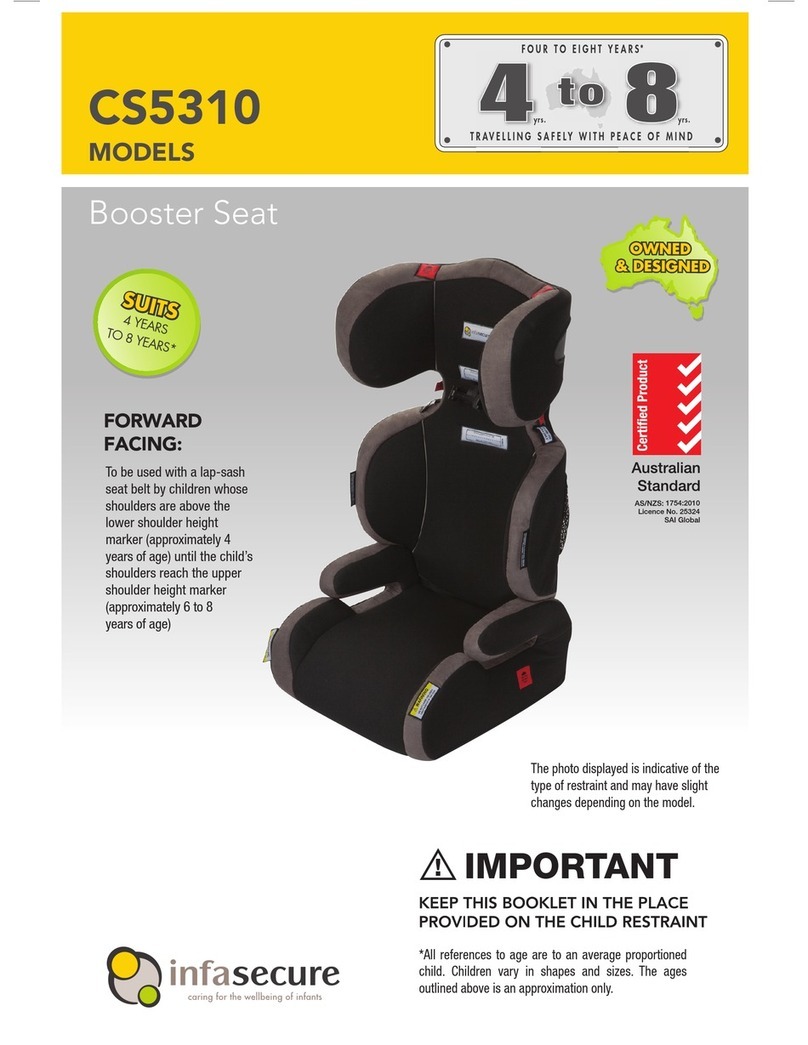
infa-secure
infa-secure CS5310 instructions

MaxiCosi
MaxiCosi RodiFix AirProtect Instructions for use
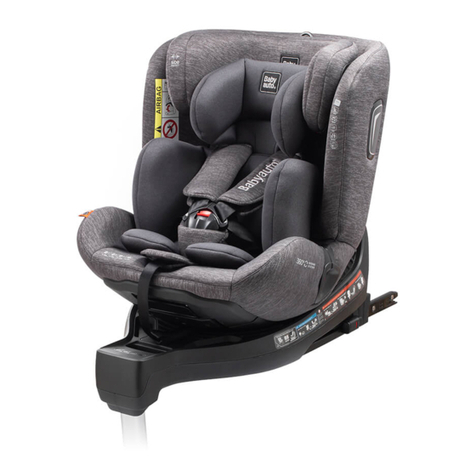
Babyauto
Babyauto TEKIE CLASSIC instruction manual
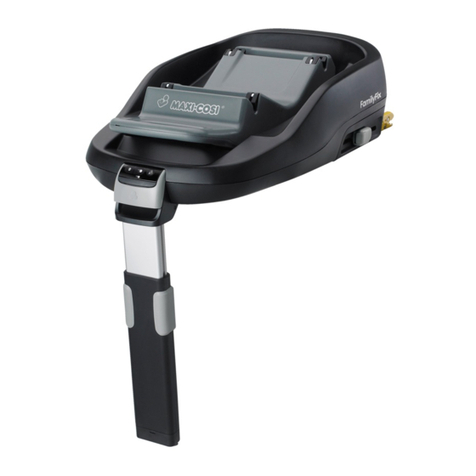
MaxiCosi
MaxiCosi FAMILYFIX Instructions for use
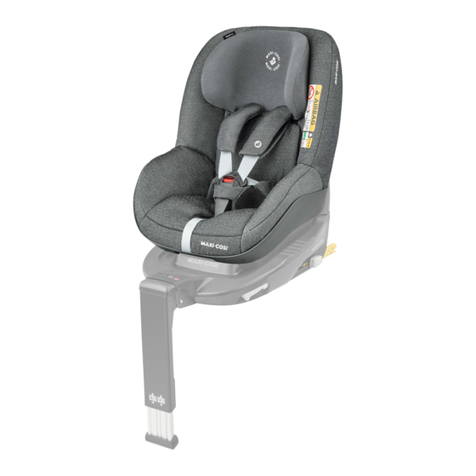
MaxiCosi
MaxiCosi Pearl Pro i-Size manual
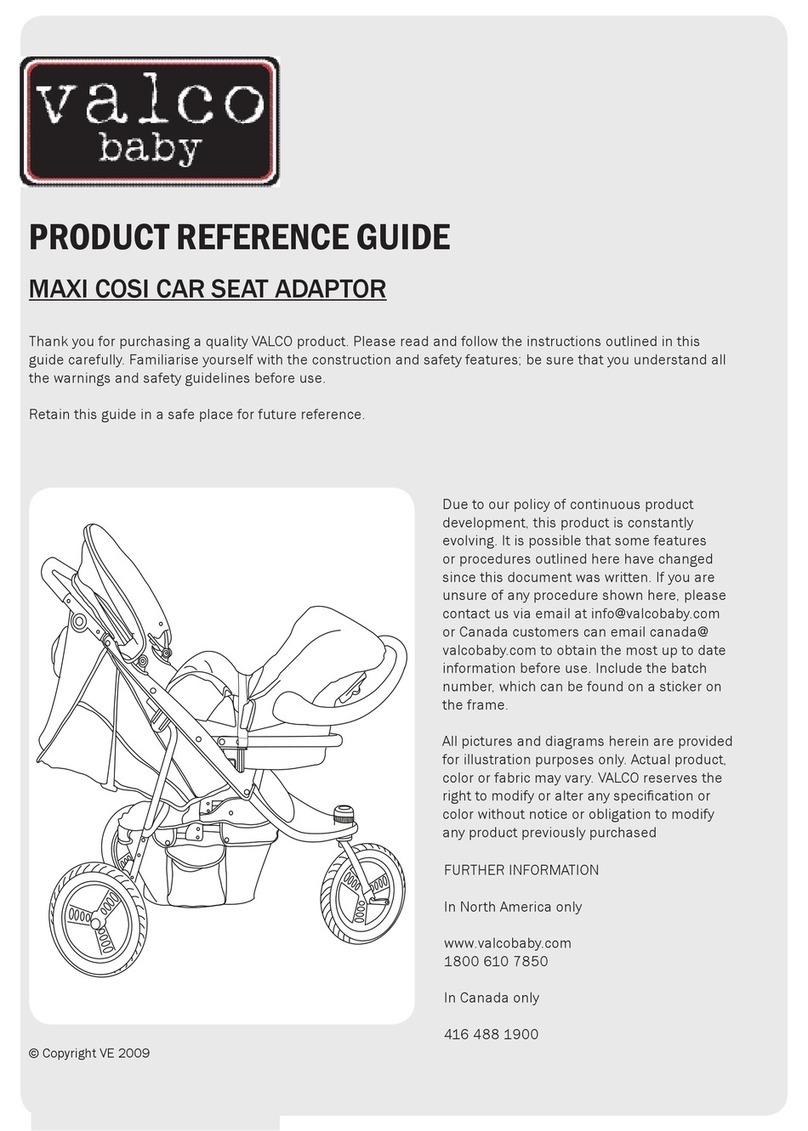
VALCOBABY
VALCOBABY Maxi Cosi Car Seat Adaptor Product reference guide
